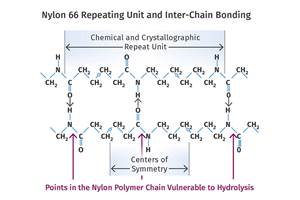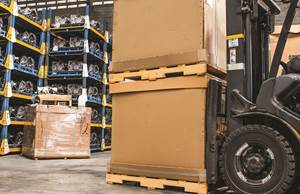Asahi Kasei Aims for ‘First-to-Market’ of a More Sustainable Nylon 66
In addition, Asahi Kasei Plastics North America (APNA) is on a roll with its expanded Leona portfolio of specialty nylon 66-based compounds.
Vertically integrated with parent company, compounder of specialty, high-performance, engineered polymers such a nylon 66-based, PPE, and chemically-coupled PP, Asahi Kasei Plastics North America (APNA) is developing and launching new engineered compounds for automotive applications, particularly for the electrification of automobiles.
Moreover, parent company Asahi Kasei Corporation is developing more sustainable versions of its innovative compounds through industry partnerships. As we have previously reported, it has teamed up with biotechnology firm Genomatica to commercialize renewably-sourced nylon 66. The partnership entails the use of Genomatica’s biobased HMD (hexamethylenediamine, also abbreviated as HMDA) building block. Genomatica has been able to change the DNA on certain bacteria so that they produce HMD after ‘eating’ sugars that do not disrupt the food chain in any way. Currently, HMD accounts for roughly half of the makeup of Leona nylon compounds, making this a significant step towards sustainability.
Asahi Kasei sees this collaboration as key to supporting its goal to be first-to-market with a more sustainable nylon 66 for the automotive and electronics industries, utilizing bio-HMD, and to accelerate the achievement of its corporate sustainability objectives. Asahi Kasei Corporation has preferential access to early volumes of renewably-sourced HMD and nylon application testing, leveraging the company’s expertise in developing successful nylon applications for use in products such as high-temperature automotive parts, electronics, or yarns to produce airbags. Asahi Kasei will have the opportunity to license Genomatica’s Geno HMD process technology to commercialize biobased nylon 66 once the technology is completed. While timetables are not currently being disclosed, Asahi Kasei is confident that its nylon-66 made with bio-HMD will have all the same quality and performance as it does now.

Meanwhile, I recently had the pleasure to interview industry veteran Todd Glogovsky, president and COO of APNA. Glogovsky has over 25 years of experience in the plastics industry supporting technology, sales and marketing. Prior to his current role, Glogovsky was a managing director at LyondellBasell, and he also worked at Bayer. We discussed some of the latest key technology offerings launched and under development.
Included is last year’s launch of a series of halogen-free and red-phosphorus-free flame-retardant nylon 66 resins targeted to E&E applications such as breakers, magnet switches, and compressed-air valves as well as automotive applications in powertrain parts and EV charging stations. The new Leona SN series is part of the company’s Leona nylon resin portfolio which also includes the standard Leona 14G series of anti-ultraviolet nylon 66 compounds, and the special semi-aromatic Leona 90G series (a combination of nylon 66 and 6I aromatic nylon) for use in replacing metals in automotive and industrial applications. Both these series are produced with high glass content. Glogovsky notes that Leona SG compounds with high-glass content (60%) continue to replace cast metals in high-pressure, high-strength areas and beyond automotive, such as window latches.
The new halogen-free SN series resins boast UL 94 V-0 and relative tracking index (CTI) of 600 V, good surface appearance, good laser transparency (Na) and laser printability (BK). Also claimed are enhanced productivity thanks to clearer and faster laser marking on gloss surfaces, and less mold deposit than conventional halogen-free and red-phosphorus-free materials. Moreover, although the properties of similar halogen-free nylon 66 materials are significantly reduced, Leona SN compounds can still maintain a high level of tensile strength and flexural modulus after moisture absorption.
Glogovsky sees all of APNA’s flame-retardant offerings as promising contenders for expanded use in electric vehicle battery applications, noting that the EV industry is very dynamic with a lot of learning taking place. “In such battery applications, ranging from highly structured components to lighter ones, you need all of these--nylon for its high temperature resistance, PPE for its strength and dimensional stability, and PP for its chemical resistance and lower pricing.”
Related Content
Automotive Awards Highlight Emerging Technologies
Annual SPE Automotive event gives nods to several ‘firsts’ as well as sustainability.
Read MoreWhat is the Allowable Moisture Content in Nylons? It Depends (Part 1)
A lot of the nylon that is processed is filled or reinforced, but the data sheets generally don’t account for this, making drying recommendations confusing. Here’s what you need to know.
Read MoreGeneral Polymers Thermoplastics to Further Expand Distribution Business
NPE2024: Following the company’s recent partnership buyout, new North American geographic territories are in its sight.
Read MoreThe Fantasy and Reality of Raw Material Shelf Life: Part 1
Is a two-year-old hygroscopic resin kept in its original packaging still useful? Let’s try to answer that question and clear up some misconceptions.
Read MoreRead Next
People 4.0 – How to Get Buy-In from Your Staff for Industry 4.0 Systems
Implementing a production monitoring system as the foundation of a ‘smart factory’ is about integrating people with new technology as much as it is about integrating machines and computers. Here are tips from a company that has gone through the process.
Read MoreBeyond Prototypes: 8 Ways the Plastics Industry Is Using 3D Printing
Plastics processors are finding applications for 3D printing around the plant and across the supply chain. Here are 8 examples to look for at NPE2024.
Read MoreFor PLASTICS' CEO Seaholm, NPE to Shine Light on Sustainability Successes
With advocacy, communication and sustainability as three main pillars, Seaholm leads a trade association to NPE that ‘is more active today than we have ever been.’
Read More












